#other listed characters include roughly half the homestuck girls
Explore tagged Tumblr posts
Text
The recent addition of Leonie Fire Emblem to my favorite characters list is proof that I have a type, and that type is "tough young women with a boatload of tenacity and also So Many Problems Like Good Lord Girl Get A Therapist"
#other listed characters include roughly half the homestuck girls#multiple of my OCs#and spider gwen#there are probably more but I can't think of them off the top of my head#OH YEAH Claudia Dragon Prince and Catra. surprisingly not Glimmer although she absolutely fits the bill#oh and when I say type I do not mean it in an attractiveness way#I have no idea how all this reflects on me#ooh ooh and Chloe Price and maybe Kate Marsh too. depends on how you interpret the latter's character#I personally think that just because Kate's gentle and kind doesn't mean she doesn't have a strong core#Max Caulfield on the other hand is I don't know. she's pretty wishy-washy. but I guess she counts#okay NOW I'm done.#meow shut up challenge#WAIT NO CASS CAIN ABSOLUTELY FITS THE MOLD. babs too#Alphys is too weak Undyne too well-adjusted and Eda too old to count#okay MAYBE undyne counts. she has Anger Management Issues#going to post now and ultimately regret not adding more characters later. but oh well
3 notes
·
View notes
Text
Oh Fuck I’m TV Troping: A Short & Incomplete List of Bad Girls
Since that whole post about Bad Girls and Compassionate Male Heroes kinda blew up and the discussion just... isn’t stopping, I’ve been thinking of this trope a lot and uh, I guess I’m gonna list a bunch of examples of it since I’ve kinda been doing it already and it’d be nice to have them all in one spot I guess. Gonna put a cut because even though I don’t want to make a huge list, I still think this is gonna be long.
4 Tried and True Bad Girls - the following fit the archetype as I roughly defined it here pretty much to the letter. Of course, the thing about archetypes and tropes is that you don’t have to hit every single detail to still “count,” but it’s good to have a baseline.
Jessie
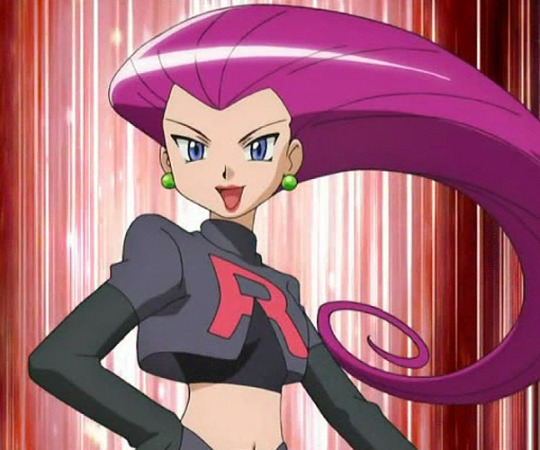
A member of an international crime syndicate, a notorious thief, and a recurring antagonist for the hero, Jessie from Pokemon is an excellent example of the Bad Girl trope because if you remove female pronouns while describing her, she basically fits the stock Bad Boy traits to a T. Aggressive and arrogant? Check. Prone to violent outbursts? Check. Intensely jealous of people who seem to have it easier? Check. Hidden tender side and tragic backstory? Check. Also she’s one half of the greatest romantic couple ever portrayed in fiction - and her counterpart is a compassionate, sweet-natured guy to boot!
Ryoko
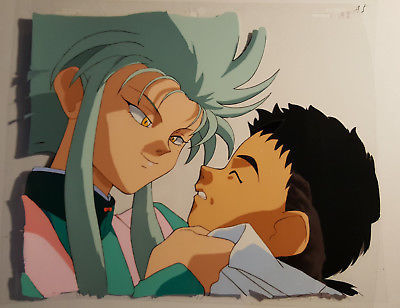
I’m not going to fill this up with anime examples (though I probably could - Bad Girls are much more common in Japanese media), but I couldn’t resist including Ryoko, because she’s not just a Bad Girl - she’s a PIRATE, which, if my grandma’s collection of romance novels was anything to go by, is an incredibly popular occupation for a Bad Boy to have! More than that, she’s a space pirate, the plunderer of countless worlds, wanted by the space police force and considered a villain of legendary power. More than that, she can wield store brand lightsabers, shoot lasers out of her hands, and even spent a good chunk of time as a mummy! Ryoko’s personality is pure Dashing Rogue, the Bad Boy Girl who’s definitely a scoundrel but, maybe, just maybe, the kind of scoundrel who’s got a good heart. She definitely pines for love and an amount of stability, though she doesn’t want to stop traveling the stars as a boozing adventurer who gets into the most ludicrous scrapes. Everything about Ryoko plays up the ideas of a Bad Boy romance with the flair for drama and fantasy that a space opera can provide, except the Bad Boy is a girl and the sweet ingenue heroine is a boy.
Ryoko is who you wish Jack Sparrow would be.
Faith
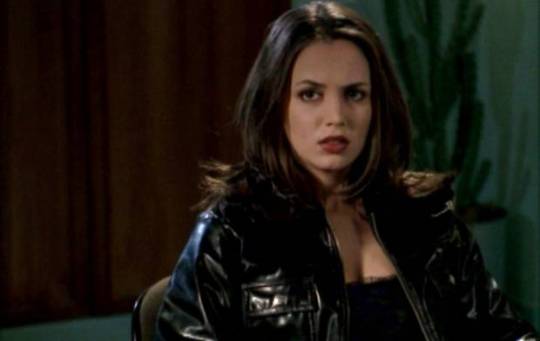
Faith was introduced as a second Slayer in Buffy the Vampire Slayer, which was the result of magical shenanigans that suddenly rendered the whole “there can only be one slayer at a time” rule kinda moot. Ok that’s an extremely abbreviated summary and it’s really more complicated than that but I can already feel the non-Buffy fans falling asleep so let’s stay focused.
Since Buffy is, y’know, the main character, Faith was brought on to be her foil - an example of what Buffy wasn’t, but possibly could become. And since BtVS was a horror dramedy, Faith wasn’t a GOOD alternative - she was, explicitly, Buffy’s dark counterpart, from her brunette hair to her heavy and darker makeup to her rad leather jacket and, as the show frequently said, “slutty” wardrobe. Faith was more violent, more sexual, and more apathetic to others than Buffy was, and holy fuck did the show just hate her for it. Almost every character in it treated her like shit, with her sexuality in particular being a sticking point for many of them.
Faith is particularly interesting because she differs from Buffy (and the female cast at large) in almost the exact same ways that the show’s main Bad Boys, Angel and Spike, differed from its male characters - more violent, more sexual, darker clothes, etc. But while Angel and Spike get a great deal of sympathy from the narrative, Faith... didn’t. I mean they kinda sorta gave her some eventually, but most of it played out in the spinoff Angel, and the other characters continued to hold a grudge against her. Faith isn’t just an good example of the Bad Girl trope - she’s an example of how the reaction to Bad Girls differs from the reaction to Bad Boys, despite them being almost exactly the same.
Vriska Serket
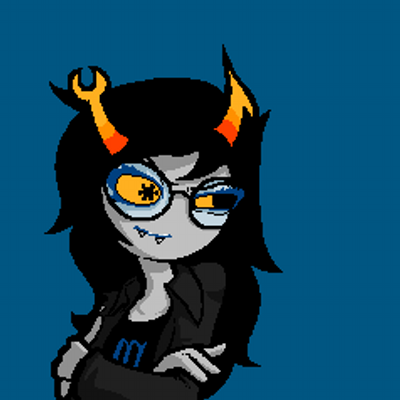
OH FUCK IT’S HOMESTUCK
Ok, everyone still hates Homestuck, so I won’t belabor this point, but Vriska Serket, who is infamously the most divisive character in the entire story, is absolutely a bad girl. Arrogant, ruthless, abrasive, with a tragic backstory, a desire for both compassion and redemption, and a truly ambitious schemer, she ticks so many boxes and OH SHIT SHE’S ALSO A PIRATE. Like Faith, Vriska was in a story that had a lot of examples of Bad Boys too, and while the fandom fucking HATES Vriska, her Bad Boy counterparts are nowhere near as divisive, with one of them being extremely popular despite being a clown who murders people. The other one explicitly wants to commit genocide, literally saying almost exactly that, and is also far more well liked. WHY IS THIS?
But enough of the homestucks! Let’s move onto some...
Borderline Bad Girls - these ladies don’t fit the trope quite as neatly, but I still think they capture the jist, or at least used it as a base before experimenting in different directions. They are, at the very least, closer to the Bad Girl archetype than its sibling tropes, the Badass Heroine and the Femme Fatale.
Jessica Jones
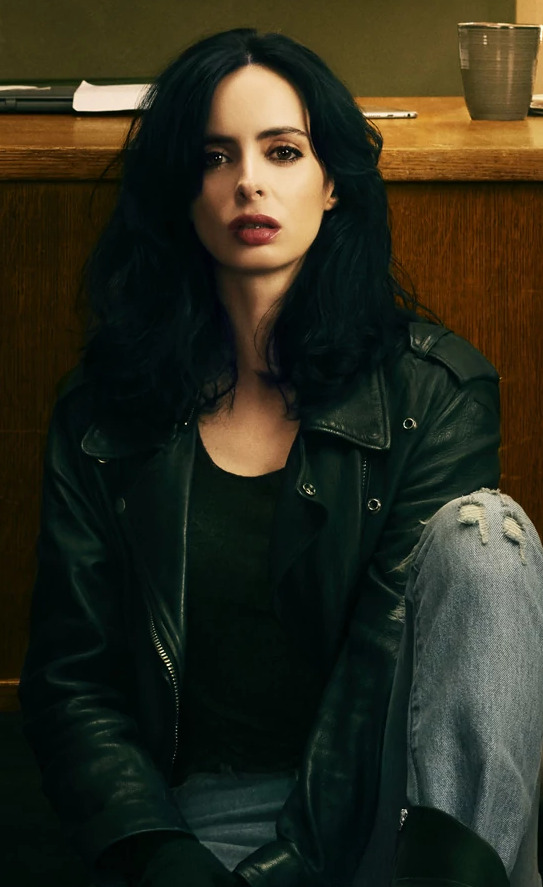
I’m just gonna talk about the Netflix incarnation of this character, as I have not read the comic books featuring Jessica Jones and thus cannot comment on them.
The only real strike against Jessica Jones is that she isn’t a supporting cast member, like pretty much all other Bad Girls are. She’s the protagonist, the titular main character. That’s a unique honor for a Bad Girl to have! Otherwise, she fits - hard drinking, abrasive, rude, surly as hell, but with a tender heart, a tragic backstory, and a desire for redemption. Hell she’s even wearing the Bad Girl leather jacket.
Morrigan
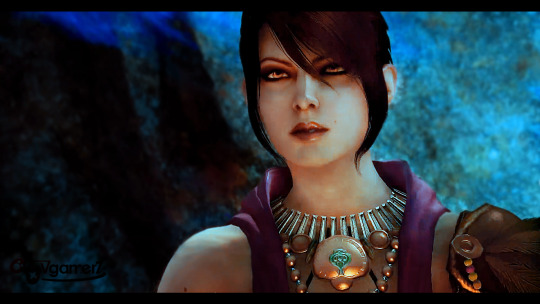
Ok, we’re straying a bit far here, but I’m going to try to make a case here. Morrigan’s rudeness and abrasiveness isn’t quite as bombastic as the standard take on the Bad Girl trope - she actually phrases things very politely and speaks very softly most of the time, and is generally cordial to people when they are cordial to her. It’s the content of what she says, rather than the way she says it, that sets most people off. There’s also an odd naivety to Morrigan’s interactions that isn’t immediately noticeable because her vocabulary is so, well, verbose. She doesn’t make the “ill tempered thug” impression most Bad Girls make when they’re first introduced - she instead comes off as very sophisticated yet oddly ignorant of the civilized world, which is a very different starting point for a Bad Girl.
BUT! Morrigan’s character arc follows the rough path of a Bad Girl. She verbalizes a lot of callous and cruel ideas about the world when you first meet her, giving the impression that she is some sort of sadistic monster. It’s done in a very different way than the standard Bad Boy/Bad Girl, but it has the same effect - you are led to think this girl is a Bad Person very early on. And yes, to some extent she is - but, just like any other Bad Boy/Bad Girl, her actions later on show that’s not all there is to her, that, even if she isn’t aware of it, there is a loving core to Morrigan - she wants to be good.
Like most Bad Boys/Bad Girls, it’s eventually revealed that Morrigan’s childhood situation was NOT GREAT, and that she has been the victim of abuse and some very bad parenting. A great deal of her wickedness isn’t inherent to her, but something she was indoctrinated into - and, in TRUE Bad Boy/Bad Girl fashion, love, especially romantic love, makes her doubt her view of the world. It begins to break apart, and she gradually learns, to her confusion, horror, and eventually, hope, that there is another way to live - a better, kinder way.
One might argue that Morrigan doesn’t fit the Bad Girl trope, but another villainous female archetype instead. For instance, one might say she is instead a Femme Fatale, since she dresses all sexy like and whatnot - but Morrigan doesn’t really seduce people all that often in the narrative. Early on in the first Dragon Age game you have an option to ask her to seduce a guard, and Morrigan not only reacts in disgust, but instead horrifies the guard into letting you by instead (because Morrigan is great). The only time she does seduce someone is specifically to keep the main characters from an otherwise inevitable death via a dark magic ritual - and yes it does feel ridiculous to type that out, but 1. it makes more sense in context and 2. I think the ridiculous circumstances of this seduction kinda illustrates why it’s not really a core character trait of hers, which is why she doesn’t fit the Femme Fatale mold. Likewise, while one could say she fits the idea of a Vain Sorceress... well, other than being pretty and using magic, Morrigian really doesn’t. She’s not motivated by preserving her youth, and doesn’t really seem to care much for traditional beauty standards at all if her conversation with Leliana is anything to go by (though she does meet them anyway because, well, Video Games). Morrigan doesn’t really fit any villainous female archetype perfectly, but if we accept her as a Bad Girl, she makes for a particularly interesting example.
Hexadecimal

Straying further! Like Morrigan, one might be tempted to put Hexadecimal in the Vain Sorceress or Femme Fatale archetypes instead, but again, like Morrigan, she really doesn’t act like either of those two despite being a sexy lady who uses magic for villainous ends. Instead she’s defined by being the sort of superhero/action adventure cartoon variety of “crazy,” which isn’t based on any real mental illness, but rather an excuse for her to cause a lot of mayhem for no real reason. Unlike most “crazy” villains, though, Hex’s insanity is treated with sympathy by the narrative and the main hero - while most people would be willing to write Hex off as someone they’d rather live without, Bob, the hero, continually tries to reason with her and help her overcome her madness.
Most people wrote her off as a lost cause, but the hero showed her compassion. There’s smackings of a Bad Boy in that.
As the show goes on, Bob’s compassion for Hexadecimal is repaid with her own affection, and she slowly turns from villain to hero out of a desire to not only keep Bob safe, but make sure he’s happy - and she comes to realize he can’t be happy without the people he loves. Hex becomes a truly tragic and noble character towards the end of the show, as she knows Bob will never reciprocate her romantic affections but still remains on his side anyway, even saving the lives of people who argued against saving her. A villain who seems like a frothing mad dog, only to be turned into a hero after the compassion of a hero makes them realize the value of human life? That’s is SUCH a Bad Boy arc. Hexadecimal may not fit some of the aesthetic trappings of the Bad Girl archetype, but her arc fits it perfectly.
Harley Quinn

When she was first introduced, Harley Quinn wasn’t a Bad Girl so much as she was, like, the perky love interest of a bad guy. She wasn’t given enough focus and agency in the narrative to really fit the Bad Girl archetype. However, in recent years she’s been retooled a bit to work independently of the character she was designed to orbit, and as a result she may be our second example of a Bad Girl protagonist. She’s a supervillain, or at least was, and was in league with one of the worst at that. She’s loud and aggressive in combat, has a big bombastic personality, and revels in living an anarchic lifestyle. But, as her solo series shows, she does have a good heart deep down, adopting stray dogs and helping out fellow weirdos who have been left behind by a world that doesn’t give a damn about them. Harley Quinn is and has always been defined by her desire to be loved, which is very much a Bad Girl sort of trait - especially since that desire often leads to her acting out, just as most Bad Boys and Bad Girls act out because, ultimately, they haven’t been shown enough love.
Plus a lot of her modern designs add a leather jacket, and it just seems that once a girl wears a leather jacket she has at least a 70% chance of being a Bad Girl.
Azula, Mai, and Ty Lee
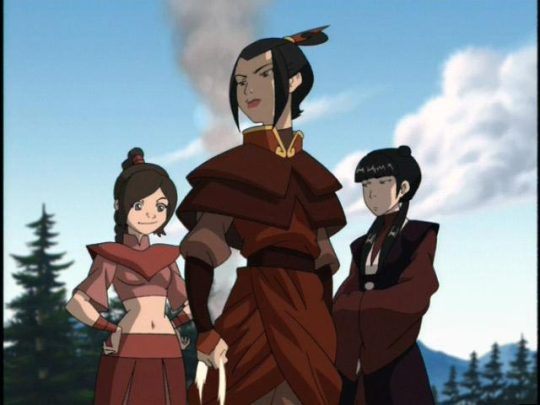
I had no idea where to put these ladies and whether or not they fit this archetype, but I felt they had to be noted because they’re very well known examples of complicated female villains who don’t fit the Femme Fatale archetype at all, which in turn makes them feel like pretty good candidates for Bad Girl-dom. Azula probably fits the archetype the closest, though you don’t see her desire for compassion until VERY late in the series (where she is, sadly, too far gone to get her redemption). Mai comes in close second, though her sullen demeanor oddly fits the Badass Heroine a bit better. And then Ty Lee... Ty Lee... I mean she’s like an even sweeter and kinder Harley Quinn, she hardly even counts as a villain except she works with the bad guys... I don’t know what we do with Ty Lee, guys. Ty Lee’s just her own thing.
60 notes
·
View notes